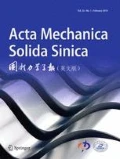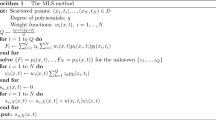Abstract
The aim of this paper is to introduce a new semi-analytical method named precise integration method of lines (PIMOL), which is developed and used to solve the ordinary differential equation (ODE) systems based on the finite difference method of lines and the precise integration method. The irregular domain problem is mainly discussed in this paper. Three classical examples of Poisson’s equation problems are given, including one regular and two irregular domain examples. The PIMOL reduces a semi-discrete ODE problem to a linear algebraic matrix equation and does not require domain mapping for treating the irregular domain problem. Numerical results show that the PIMOL is a powerful method.










Similar content being viewed by others
References
Liskovets A. The method of lines (review). English translation appeared in “Differential Equation”, 1965;1:1308–23.
Meyer GH. An application of the method of lines to mutidimensional free boundary problems. J Inst Math Appl. 1977;20(3):317–29.
Meyer GH. The method of line for Poisson’s equation with nonlinear or free boundary conditions. Numer Math. 1978;29:329–44.
Meyer GH. The method of line and invariant imbedding for elliptic and parabolic free boundary problem. SIAM J Numer Anal. 1981;18(1):150–64.
Janac K. Hybrid solution of the Poisson equation. In: Vichnetsky R, editor. Advances in computer methods for partial differential equation; 1975. p. 154–8.
Irobe M. Method of numerical analysis for three dimensional elastic problem. In: Proceedings of the 16th Japan national congress for applied mechanics. Central Scientific Publ.; 1968. p. 1–7.
Gyekenyesi JP, Mendelson A. Three-dimensional elastic stress and displacement analysis of finite geometry solids containing cracks. Int J Fract. 1975;11(3):409–29.
Malik SN, Fu LS. Elastic–plastic response of an externally cracked cylinder analyzed by the method of lines. Eng Fract Mech. 1979;12(3):377–85.
Fu LS, Malik SN. The method lf lines applied to crack problems including the plasticity effect. Comput Struct. 1979;10(3):447–56.
Mendelson A, Alam J. The use of the method of lines in 3-D fracture mechanics analyses with applications to compact tension specimens. Int J Fract. 1983;22:105–16.
Alam J, Mendelson A. Elastic–plastic stress analysis of CT specimens. Int J Fract. 1986;31:17–28.
Jones DJ, South JC Jr, Klunker EB. On the numerical solution of elliptic partial differential equations by the method of lines. J Comput Phys. 1972;9(3):496–527.
Xanthis LS. The numerical method of lines (MOL) and ODE solvers can provide a new powerful computational fracture mechanics tool. In: International conference on computational mechanics, Tokyo Japan; 1986.
Xanthis LS. A pseudo-ODE modeling trick for the direct method of lines computation of important fracture mechanics parameters. ACM SIGNUM Newsl. 1986;21(1–2):10–6.
Yuan S. The finite element method of lines: theory and applications. Beijing: Science Press; 1993.
Xanthis LS, Schwab C. The method of arbitrary lines. C R Acad Sci Paris. 1991;312(1):181–7.
Yuan S. The finite element method of lines. J Numer Methods Comput Appl. 1992;13(4):252–60 (in Chinese).
Zhong WX. On precise integration method. J Comput Appl Math. 2004;163:59–78.
Moler CB, Van Loan CF. Nineteen dubious ways to compute exponential of a matrix. SIAM Rev. 1978;20:801–36.
Zhong WX, Zhu JP, Zhong XX. A precise time integration algorithm for nonlinear systems. In: Proceedings of WCCM-3; 1994;(1). p. 12–7.
Xu YJ. PIMOL: a new semi-analytical method based on the finite difference method of lines and the precise integration method. Acta Mechanica Solida Sinica. 2019. https://doi.org/10.1007/s10338-019-00151-1.
Maple 17, Maplesoft, a division of Waterloo Maple Inc. 1981–2013.
Timoshenko SP, Goodier JN. Theory of elasticity. 3rd ed. New York: McGraw-Hill; 1970.
Author information
Authors and Affiliations
Corresponding author
Rights and permissions
About this article
Cite this article
Xu, Y. PIMOL: The Finite Difference Method of Lines Based on the Precise Integration Method for an Arbitrary Irregular Domain. Acta Mech. Solida Sin. 33, 823–835 (2020). https://doi.org/10.1007/s10338-020-00165-0
Received:
Revised:
Accepted:
Published:
Issue Date:
DOI: https://doi.org/10.1007/s10338-020-00165-0




